While it’s true that Myrtle Beach, South Carolina, is one of the most popular golf markets in America, it’s not the only game in town (so to speak). A couple of miles northeast of Myrtle Beach, along the Atlantic Coast of North Carolina, is an area known as the Brunswick Islands. There are five islands in the group: Sunset Beach, Ocean Isle Beach, Holden Beach, Oak Island and Bald Head Island. The Brunswick Island area includes a portion of the North Carolina mainland. It stretches some 50 miles from the S.C. state line up to the city of Wilmington on the eastern side of the Cape Fear River.
As I expected, the area is quite beautiful. There are many quaint towns to visit, superb seafood to consume, a wide variety of good-to-great accommodations to choose from, and activities galore. You may find yourself boating, canoeing, kayaking, fishing, shopping, and simply taking a walk along the ocean. What I didn’t expect is that the golf courses throughout this area are as good, and in some ways better, as those to be found around that famous destination just down the coast.
The big difference is the number of them. While Myrtle Beach boasts nearly 100 facilities to choose from, the Brunswick Island area features just over 30. With so many golfers traditionally flocking further south, what this area has to offer is easier access, more attractive fees, and excellent conditions. Based on the five courses I played there, I’ll take quality over quantity any day.
Cape Fear National at Brunswick Forest is a Tim Cate design that opened in 2010. Shortly after, GOLF Magazine, Links Magazine and Golfweek named it one of the best new courses of the year. Located in Leland just a few miles west of historic downtown Wilmington, Cape Fear is a big, beautiful and very challenging layout that measures 7,217 yards from the back tees (four other markers are available measuring between 6,686 yards and 4,802 yards). Due in part to the clumps of native grasses that are scattered about, and the stands of towering pine trees that are so often in view, there’s a sense of wildness here that I really liked. Being a nature lover as well as a golfer, I also enjoyed the frequent sights of wildflowers and wildlife (spotting a redheaded woodpecker on the gorgeous par-4 12th was pretty cool). However playing it, I found Cape Fear a bit frightening. For one reason, water is in play on 15 of the 18 holes. Adding to the intimidation factor are the numerous forced carries — off the tee or on the approach — over water, wetlands and/or waste bunkers. The greens are challenging as well; they’re quite large, well sloped and well protected. Looking back, though, my fear was my fault: I played from the wrong tees. Being both a senior and a short hitter, had I played from the 5,603-yard silver tees instead of the 6,195-yard tees, I would have been less intimidated and perhaps would have shot a better score. What’s certain is that I would have enjoyed this lovely layout a great deal more.
Sandpiper Bay Golf and Country Club in Sunset Beach is a 27-hole facility that was designed by Dan Maples, grandson of Frank Maples, long-time construction foreman for one of golf’s greatest course architects: Donald Ross. The original nines at Sandpiper Bay (Sand and Piper) opened in 1987; the third nine (Bay) was built in 2002. Of the three combinations available, the Piper nine and Bay nine measure the longest at 6,849 yards from the back tees. The Sand and Bay nines tip-out at 6,641 yards, while the Sand and Piper combo is the shortest at 6,590 yards from the tips (three other tees are available on each nine). Although I only played the Sand and Bay, I’m going to assume the Piper course is similar: very pretty, very playable and a lot of fun — but not easy. The Sand course is a parkland-style layout that features numerous tree-lined holes, minimal water in play, well-placed bunkers, and good- sized greens that can be quite challenging if you’re on the wrong side of the hole. By contrast, the Bay nine at Sandpiper Bay is mostly about water; it’s in play somewhere on every hole. On several holes, instead of trees bordering the fairways, there are homes on one side or the other or both. For a first-time visitor, both of these types of “hazards” can make a course that looks wide off the tee — as the Bay does — actually feel a lot narrower. This is especially true on the longer holes because you’re simply not sure if that lake or pond you see in the distance is as far away as it appears, and/or whether the hole is also sloped in that direction. The resulting confusion, of course, can cause doubt and doubt can often lead to sweaty palms, the dry heaves and some awful tee shots. I can attest to this. Thankfully, though, the greens on the beautiful Bay nine are quite large and fairly easy to hit — which comes in handy when you’re lying three instead of two. Should I get the chance to play the Bay nine again — and I hope I do — for sure I’ll play it differently than the first time.
Brunswick Plantation and Golf Resort, in Calabash, is another beautiful 27-hole facility that dates back to 1991. Eighteen of the holes were designed by Willard Byrd, while the third nine was created by Clyde Johnston. All are very pretty, challenging and fun to play. The golf courses (Azalea, Dogwood and Magnolia) are centerpiece to a massive residential, retirement and vacation community. There are more than 1,500 property owners at Brunswick Plantation. They come from 36 states and as far away as England and Germany. And no wonder. In addition to the fine golf, the facility features two Plantation-style clubhouses, two indoor pools, five outdoor pools, four fitness centers, three amenity centers, several tennis courts, and miles of walking trails.
Brunswick Plantation and Golf Resort is also minutes away from the beaches, marinas and a score of excellent seafood restaurants. The town of Calabash is frequently referred to as the “Seafood Capital of the World” and is homeport to the Hurricane Fishing Fleet (available for deep-sea fishing, shrimping and ocean excursions).
Ocean Ridge Plantation is a 72-hole facility headquartered in Ocean Isle Beach. Its four courses — collectively known as “The Big Cats” — are Tiger’s Eye, Lion’s Paw, Panther’s Run and Leopard’s Chase. Tiger’s Eye, located in Sunset Beach, is a Tim Cate design that opened in 2000. In 2010, GOLF Magazine ranked Tiger’s Eye the No. 8 course in North Carolina. Considering the number of great courses the “Tar Heel” state has to offer, that’s high praise indeed. Even though it only measures 7,014 yards from the tips — short by PGA Tour standards — Tiger’s Eye looks and plays bigger. One of the reasons it looks so big, I thought, was because of the numerous stands of extremely tall trees that frame many of the holes. These trees are so high and thick in places (much the same way it is on many courses in Northern Michigan) that it can make you feel as if you’re the only one out there playing. The reason it plays bigger is because of the surprising elevation changes to be found here — up to 60 feet in spots. Northern In spite of how big it feels, my two favorite holes at Tiger’s Eye are par 3s: the sixth and the 11th. The sixth features a large peninsula green protected on three sides by sand; the 11th is highlighted by a much smaller peninsula putting surface that’s guarded on three sides by — you guessed it — water. They’re just two of the really enjoyable holes on a very good golf course.
The final course I played on my visit to the Brunswick Island area was also my favorite: Farmstead Golf Links in Calabash. D esigned by architects Willard Byrd and Dave Johnson, Farmstead is a fun, friendly but challenging layout that opened in 2001. To say it’s unique is an understatement. For one thing, even though Farmstead is officially located in North Carolina, several parts of the course are actually in South Carolina. How will you know when you’re in South Carolina? Because you won’t see Farmstead’s beverage cart. The course opts not to have a South Carolina liquor license so no alcohol can be sold on those few holes. If the beverage cart shows up, you’re back in N.C. This is good to know because you may want to stock up. There’s plenty of trouble on this golf course (water is in play somewhere on every hole) and you may need a bit of “courage” to help you deal with it. As challenging as it can be, Farmstead is very playable if you pick the tees that match your ability. Five sets of markers are available with the longest measuring 7,242 yards. But even if you choose to play from one of the shorter tees, I highly recommend that you take on Farmstead’s 18th from the back tee. Talk about a spectacular hole! First of all, it’s a par-6. Secondly, it measures 767 yards from the tips. Thirdly, it starts in South Carolina and ends in North Carolina. Farmstead’s 18th is a fantastic finish to a sensational golf course and it’s a memorable way to end any trip to one of the best but least well known golf destinations in America: North Carolina’s Brunswick Islands.
Please visit www.ncbrunswickgolf.com.
Top photo: Tiger’s Eye at Ocean Ridge Plantation.
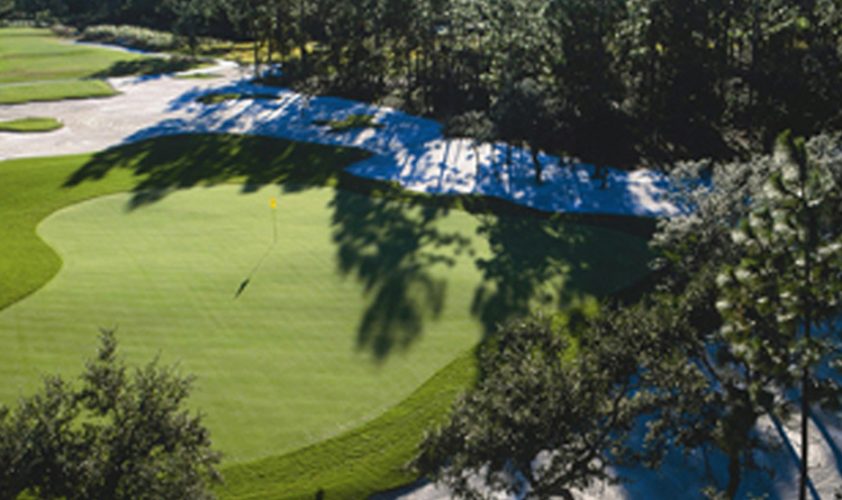
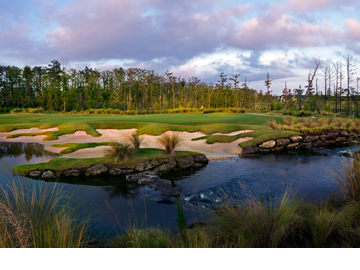
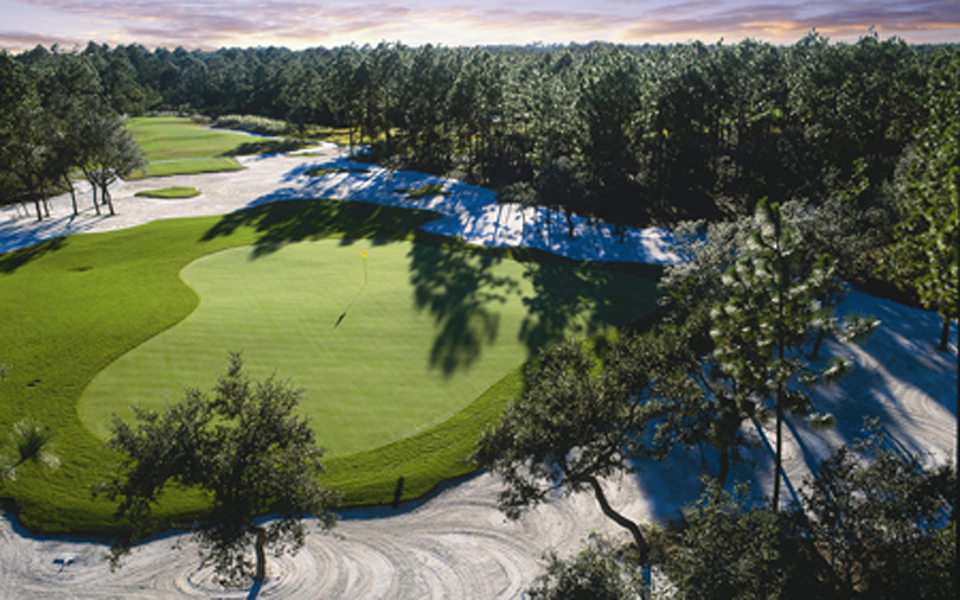
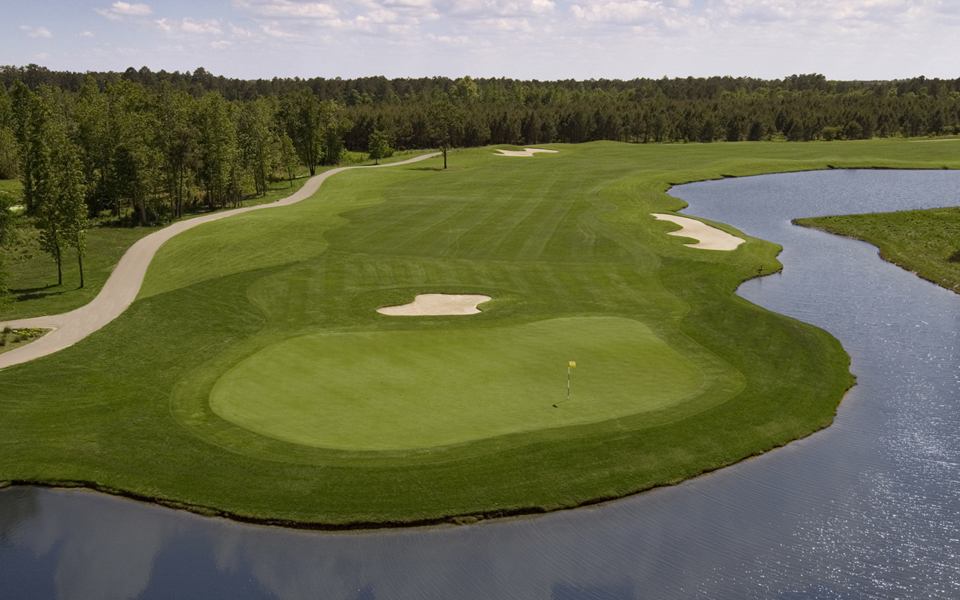
 ';
';
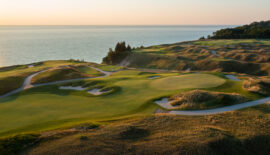 ';
';
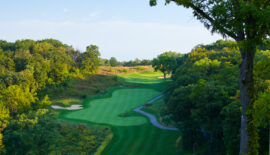 ';
';
 ';
';